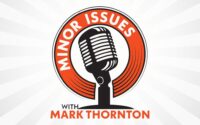The Bottlenecks In The Economy Are Breaking
CORK EXPLODING FROM CHAMPAGNE BOTTLE
Consider this clutch of Wall Street Journal headlines, mostly from last week.
- “Cotton prices have dropped back to earth.” – (Sept 30, 2022)
- “Lumber prices have fallen to their lowest level in more than two years, back to what they cost before the pandemic.” (Sept 27, 2022)
- “Copper prices have fallen to their lowest level in nearly two years” (July 7, 2022)
- “Oil Prices Slump… U.S. crude has shed about $35 a barrel in three months.” (Sept 13, 2022)
- “Rents Drop for First Time in Two Years” ( Sept 26, 2022)
- “Home Prices Suffer First Monthly Decline in Years.” (Sept 27, 2022)
ADVERTISEMENT
Something important is happening. It’s called…. Deflation.
The Supply-Side Shocks
The Pandemic, and the War in Ukraine – two once-in-a-century down-shocks – sandwiched around a $9 Trillion stimulus up-shock (by the IMF’s count) put the global economy through a massive whiplash.
- Enormous shifts in consumer behavior have occurred, generally reducing spending on services and increasing the spending on physical goods (especially durable goods) – as described in the previous column. Trillions of dollars worth of demand have been diverted in unexpected directions, flooding unprepared suppliers with unfulfillable orders (and driving up prices).
- Forecasting errors by manufacturers have propagated all through the supply chain, creating shortages everywhere, from supermarket shelves to auto dealers’ lots, as logistics managers struggled to cope with the business-as-not-usual
- The shortages, sanctions and sabotage caused by the Ukraine War have further dislocated the global economy, especially the financial and energy sectors.
- Covid Lockdowns, quarantines and travel bans have paralyzed critical segments of the production cycle, especially in China.
ADVERTISEMENT
All this has generated great stress on the vast and intricate supply chains that the modern world depends upon to produce and deliver those goods.
It has also impacted the public psychology, damaging consumer confidence and panicking policy-makers. “Inflation” has become the fifth horseman of the apocalypse, looming over the economy. In the media today it even overshadows the traditional scourges of war (Ukraine) and disease (Covid). The staid players at the Federal Reserve, who held out for a considerable time, have now caved to the general panic. Millions of workers, apparently, are to be sacrificed (thrown out of work) – perhaps another 10-12 million jobs need to be destroyed, according to Larry Summers (the former Treasury Secretary, a ponderous intellect, has called for 10% unemployment). Houses will be lost, portfolios savaged, pensions crushed, families wrecked… Never mind – this policy must prevail, we are told, to “tame inflation.” And it would persist – the recent talking points from Fed officials include an admonition as to how it would be a terrible mistake to ease up “too soon.” The harsh regime will have to last until the Bureau of Labor Statistics calculates that its market basket (the basis of the ever-dubious Consumer Price Index) is no longer on fire, and signals the All Clear.
The Self-Healing Nature of the Supply Chain
All this angst is tragic, because it is unnecessary. The bottlenecks that have exacerbated the price inflation over the last 12-18 months are now breaking down. The critical supply constraints that fueled the price increases are beginning to ease decisively.
ADVERTISEMENT
It is our good fortune that the dominant cause of the current “inflation” is supply-side driven. Supply constraints are painful, in the moment, but they are self-healing.
We have all seen this in action. In the first days of the pandemic, the shortages were striking. Empty supermarket shelves were common. Recall the frantic search so many of us went through to find, say… hand sanitizer, deemed essential at the time. It was scarce, and dear. Or recall how difficult it was back in 2020 to find a way to get a Covid test, and how expensive if you could find it.
Yet it wasn’t very long thereafter that one began to notice that the aisles in the supermarket – now mostly full of the usual goods again – were sometimes physically obstructed… by great bins full of Purell hand sanitizer – barrels of the stuff! and often now free for the taking. Pallets of toilet paper – once hoarded – were being stacked to the ceiling in vacant corners of the store. And if you go to a CVS today, you may have to maneuver carefully around the mountains of do-it-yourself Covid test kits, at $9.99 each.
Covid Tests at CVS
ADVERTISEMENT
A more consequential, more “strategic” example: Consider how the narrative of Europe’s Ukraine-War-induced energy crisis has evolved in the past 8 months. When Russia attacked, it seemed at first unthinkable that Europe could do without Russian gas and oil. It would take years, it was said, to wean away from that dependency. Today, German gas reserves are at 91% of capacity. German customers have reduced their energy usage to an astonishing degree in a very short period of time:
- “Germany reduced its consumption of natural gas in the first five months of this year, with the decline deepening in May. Only part of the drop was due to a milder winter. Consumption slid by 35% in May compared with the same month a year ago. Adjusted for temperature effects, the drop was 11% last month.”
There is now confidence that Europe will make it through this crisis without an energy crash, and Putin’s attempted weaponization of the gas supply is headed for failure. Even this bottleneck is uncorking.
ADVERTISEMENT
This is the essential power, and the lesson, of the Market. When a disequilibrium develops, often because of an external shock, markets respond – which is to say that suppliers respond, customers adapt, and before long equilibrium is re-established. Show me a shortage, and in 3 months, or a year (depending on the type of product), I’ll show you deflation, and, in all likelihood, a glut.
This process is taking place now across many markets, impacting many commodities.
Some Examples: Copper, Cotton, Lumber, Iron Ore, Crude Oil
ADVERTISEMENT
Copper
“Doctor Copper” is a good place to start:
- “The term Doctor Copper is market lingo for this base metal that is reputed to have a ‘Ph.D. in economics’ because of its ability to predict turning points in the global economy.” – Investopedia
An employee monitors the 8mm diameter copper cable which is rolled up before passing through a … [+]
ADVERTISEMENT
Early in the pandemic, the price of copper sagged and then surged. For some the run-up was an inflation alarm. The price doubled between April 2020 and April 2021. It was up almost 50% above the long-term average. This price move was widely forecast to become a crucial inflation driver across a wide range of end-user applications.
- “Copper prices climbed to record highs for the first time in more than a decade.…one reason why some investors are girding for higher inflation.” (WSJ May 12, 2021)
Copper Price Per Metric Ton
But after stabilizing in 2021, the price of copper has been falling now for several months and is back within 13% of that pre-pandemic average. If we calculate copper’s price trend the way the CPI does it – measuring the monthly percentage change relative to the same month a year earlier – copper “inflation” has been falling for 14 months, and is now deeply negative. In other words, the copper market is seeing significant deflation.
ADVERTISEMENT
Change in Copper Price (Monthly % Year over Year)
Cotton
The trend in cotton prices is similar.
ADVERTISEMENT
CLARKSDALE, MS -OCTOBER 19: A cotton boll waits to be harvested on BTC farm October 19, 2003 near … [+]
Cotton prices Oct 2021 – Sept 2022
Cotton price increases were largely driven by supply constraints. As was reported this summer
ADVERTISEMENT
- “Southwestern cotton growers are abandoning millions of parched acres that they planted in spring, prompting forecasts for the weakest U.S. harvest in more than a decade and sending prices sharply higher.”
But the supply worries are easing, and may have been illusory.
- “Cotton prices have dropped back to earth… Futures have shed 25% since late last month, effectively eliminating gains fueled by a U.S. Department of Agriculture forecast that more than 40% of U.S. acres planted with cotton this year wouldn’t be harvested because of drought.”
ADVERTISEMENT
Lumber
- “The hottest commodity in the U.S. these days is wood.” (WSJ July 9, 2020)
CHICAGO, ILLINOIS – APRIL 05: Stacks of lumber are offered for sale at a home center on April 05, … [+]
ADVERTISEMENT
For much of 2020 and 2021, lumber prices were a prime example of what some saw as incipient inflation — although it hadn’t shown up yet, the experts were convinced it was there.
Lumber Prices Oct 2017-Sept 2022
This year the price of lumber has fallen back to its pre-pandemic level.
The Lumber market gyrations show how forecasting errors create supply-side failures.
ADVERTISEMENT
- “‘A lot of saw mills closed up shop and moved into doing maintenance and repairs, figuring demand would drop with people losing their jobs and watching their spending. What happened was just the opposite.’ [said an industry insider]. Lumber and plywood started flying off shelves. ‘People didn’t go on vacation,’ said [another insider]. ‘They stayed home and built decks, they built fences, they built pergolas. Anything and everything.’ Harvard University’s closely followed forecast of home-renovation spending predicted a slowdown…But the model couldn’t have predicted a pandemic that kept Americans at home for months. Mill orders backed up.”
The shortages spurred another problem — hoarding by customers, which is a natural response to the breakdown in the forecasting certainties. (Hoarding has played a role in exacerbating supply constraints in many other industries, such as semiconductors.) In other words, yes, there was a component of heightened demand, but the main problem was the mismatch with constrained supply.
Iron Ore
Iron Ore Production, Vale Mining (Northern System), State of Minas Gerais, Brazil. (Photo by Giles … [+]
ADVERTISEMENT
The economy is far less dependent on iron and steel than it was fifty or a hundred years ago, but it is still an important commodity. Iron ore prices surged following the Pandemic, but have now also recovered. The global price of iron ore is almost back to pre-pandemic levels. Measured in the same fashion as the CPI (year over year percentage change by month) iron ore is now in a deeply deflationary trend.
Change in Iron Ore Price (Monthly % Year over Year)
Crude Oil
Crude is the mother of all commodities. It is said to be a prime mover of inflation in the economy.
ADVERTISEMENT
CULVER CITY, CA – APRIL 25: Oil rigs extract petroleum as the price of crude oil rises to nearly … [+]
The price of oil has been severely distorted by the succession of external macro-shocks – even at one point going negative in the pandemic dislocation, and then surging when the Ukraine war started.
Crude Oil Price 2020-2022
ADVERTISEMENT
But in the last quarter it has shown a deflationary trend.
Q3 2022 Crude Oil Deflation
The news breaking today (Oct 3) is that OPEC is floating the idea of production cuts to prop up prices, and that has pushed Crude futures up 5%. Oil is a special case, certainly – its prices are not entirely “market driven.” Nevertheless, a production cut is a supply-side constraint, so if it creates “inflation” it will be part of the overall supply-driven picture.
ADVERTISEMENT
Summary: Deflation… Get Used To It
We could go on. The pattern is similar in just about every commodity market. Prices are still in many cases above pre-pandemic levels, and food prices are elevated due to the Russian blockade of Ukrainian agricultural shipments. (Again, this is clearly a supply-side constraint.) But even these prices are coming down, and moving towards the pre-pandemic levels once again.
There is a new argument on offer that these price declines are caused by weakening Demand. This is largely untrue, as of yet. A recession may be in the works, due to misguided Central Bank policies and perhaps to Xi Jinping’s ongoing blunders, but it is not here today in the U.S. and does not explain the deflationary trend across our economy in the last two quarters. The labor market is still very strong, and retail sales are healthy. The price declines are not Demand-driven. They are largely a reflection of improvements in supply.
Shocks create bottlenecks. Bottlenecks drive up prices, temporarily. The Markets are now working in their natural way to clear these bottlenecks. Further external shocks may of course disrupt this process, but the trends right now are deflationary across the commodity spectrum.
ADVERTISEMENT
For my earlier column on Supply-Driven Inflation, see What Is Really Driving “Inflation” Today
[ad_2]
Source link


